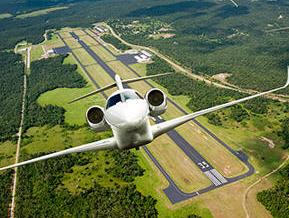|
|||||||||||
|
|
|
|||
|
By |
||||
 |
October 20, 2010 - Cessna Aircraft Company announced at the 63rd NBAA Annual Meeting and Convention the launch of the Citation Ten, a larger, advanced version of the world’s fastest certified business jet, the Citation X.
It also marks the
debut of the Garmin G5000 avionics suite and a Cessna-exclusive advanced
cabin management system, and it features more powerful and more
efficient Rolls-Royce engines.
“The launch of the Citation Ten is an example of our commitment, repeated throughout the recent downturn, to new product development, and it’s a signal that we intend to do what we need to do to maintain a general aviation industry leadership position,” said Jack Pelton, Cessna chairman, president and CEO. |
|||
|
|
||||
|
“We’ve teamed with Garmin and with Rolls-Royce to conceive an almost perfect combination of speed, performance, ease of operation and productivity in one airframe – the Citation Ten.” First flight of the new Citation Ten will be in late 2011, with certification and first delivery in 2013.
The Citation Ten
features a 15-inch longer fuselage for more cabin space, winglets for
more efficient performance, a new electrical system, dual lithium-ion
batteries, new avionics, autothrottle, a redesigned cabin with new
interior seats and cabin appointments, and a proprietary fiber
optic-based cabin management system including the latest interface
options for greater in-flight productivity and connectivity.
Performance is
also enhanced with a 211 nautical mile (391 kilometer) increase in range
at high-speed cruise, a 214-pound increase in maximum payload and a
faster rate of climb direct to 45,000 feet. “We are particularly excited
about the advanced technology incorporated throughout the aircraft and
the improved performance characteristics that give our customers a more
efficient and a more productive aircraft and aircraft cabin that are
designed to meet evolving requirements in business travel,” Pelton said.
“Further distancing this product from the competition is access to world-class customer service, not only through Cessna’s world-class support group, but also from Garmin and Rolls-Royce, with all three recently lauded in independent customer surveys,” Pelton said. |
||||
|
The Citation Ten
will use a pair of new Rolls-Royce AE 3007C2 high-flow-fan turbines,
each rated at 7,034 pounds of thrust. This gives the Citation Ten a 4
percent improvement in takeoff thrust, 9 percent improvement in climb
performance, 7 percent improvement in cruise thrust and an additional
1.4 percent improvement in specific fuel consumption. The Rolls-Royce AE
3007C2 will be certified in 2013 ahead of aircraft type certification.
Cessna is the
first company to announce it will use the integrated Garmin G5000
avionics suite, which will be certified for Federal Aviation
Administration (FAA) Federal Aviation Regulations (FAR) Part 25
operations (commercial transport aircraft).
“We have a very
successful relationship with Garmin, a company recently ranked by
aviation professionals as having the best avionics customer support in
the industry in a prestigious third-party survey,” Pelton said. “The
level of reliability and integration and the ease of use of the G5000
are going to be unprecedented and will give Citation Ten owners a new
level of operability.”
The Citation Ten’s restyled, clean cockpit design is anchored by the new, fully integrated Garmin G5000 system that centers on three 14-inch LCD primary and multifunction displays and four touch-screen control panels. Among the standard features of the new system are a pilot-vehicle touch-screen interface, TCAS II with Change 7.1, Synthetic Vision Technology, electronic charts, Garmin’s SafeTaxi, a dual flight management system with WAAS LPV and RNP 0.3 SAAAR capability, solid-state weather radar with turbulence detection and vertical scan capability, integrated terrain awareness and warning system (TAWS), ADS-B Out and Link 2000+ data link. Options include satellite weather and an ICAO Type 1A flight data recorder.
Cessna has teamed
with Dallas-based Heads Up Technologies to develop an intelligent cabin
management system (CMS) that integrates cabin electrical systems,
avionics and communications through a fiber optic backbone and an
intuitive touch-screen user interface, resulting in “the ultimate
connectivity experience.”
“Together with
Heads Up Technologies, we offer in the Ten a cabin and cabin management
system designed top to bottom for productivity,” Pelton said. “We
surround all this productivity with new styling, more space, new seats,
new lighting and more stowage – frankly more options all around to
easily meet demanding customer requirements.”
Technology is the
foundation of the Citation Ten CMS. Designers opted for exclusive use of
fiber optics instead of the more commonly used copper cable, not only
providing sufficient bandwidth for system growth but greatly reducing
aircraft weight. This size aircraft requires almost 200 feet of cable
for the CMS; a fiber optic backbone weighs less than one-tenth what a
copper cable system weighs. Aircraft using current technology CMS
architectures carry extra cable – and extra weight – to accommodate
future system expansion; if not, expansion is limited. The Citation
Ten’s fiber optic architecture is scalable, both for system growth and
for various aircraft.
The Cessna CMS features an interactive, touch-screen system controller at each passenger seat for audio (digital media, MP3/iPhone), video (digital, Blu Ray), interactive moving map, cabin temperature, lights, window shades and even cabin diagnostics. The dual club-seat cabin arrangement also includes 110 or 220 volt electrical outlets and multiple USB/device inputs. High-speed Internet browsing, satellite radio and cabin Wi-Fi are available as options. The Cessna CMS trip computer includes an interactive moving map with a global database featuring standard features like flight data displays and location indicator, and also offers access to points of interest information. |
|
|
| Other News Stories |
| ©AvStop
Online Magazine
Contact
Us
Return To News
|
|


